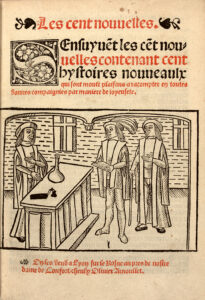Lyon, Olivier Arnoullet, 12 juillet 1532.
Gothic 4to [191 x 132 mm] of (136) ll. Blue morocco, triple gilt fillet around the covers, spine ribbed nicely decorated with gilt cypher repeated in the panels, inner gilt border, gilt over marbled edges. Trautz-Bauzonnet, 1847.
French literature’s first collection of short stories.
The most beautiful copy of this extremely rare edition of 1532 of the “Cent nouvelles nouvelles” mentioned and described by Brunet.
The work was composed between 1464 and 1467 at the court of Philip the Good, Duke of Burgundy. He is the dedicatee and is himself among the thirty-five storytellers. Long attributed to Antoine de La Sale, author of the fiftieth story, it is now admitted that the Cent Nouvelles Nouvelles were written by a single anonymous writer, who would be the thirty-sixth storyteller among the Burgundian lords.
“Masterpiece of style and, without a doubt, the first work in prose where the French language shows this clarity and easy elegance that made it the language of civilized Europe” (Viollet-le- Duc, Bibliographie des chansons, fabliaux, contes en vers et en prose, 1859, p. 144).
“A beautiful copy in g. mor. was sold 465 fr. at pr. d’Essling; 14 liv. sterl. Utterson.” (Brunet, I, 1735).
Precious and beautiful edition illustrated with 40 woodcuts within the text; a few of them repeated. title printed in red and black, decorated with a large figure: “Three characters, one of which holds a manuscript, around a table where there is a vase”. On the last l.: King of France surrounded by 6 characters. And 38 smaller woodcuts (included repeated ones) within the text. Many adorned initials.
These after drinking stories where indecency is appropriate are inspired by oral tradition and a fund common to the composed tales, Poggio’s Facetiae and the Decameron. The scabrous effects are enhanced: simpleton husbands perpetually cuckolds, beaten wives, erotic truculence, feints and word games are rendered with a very lively art of dialogue and staging.
Very beautiful copy mentioned by Brunet and Bechtel bound in morocco by Trautz with the cypher of Baron de Ruble coming from the libraries of François-Victor Masséna, Prince d’Essling (cat. 1845, n°349: copy then bound by Duru); baron Alphonse de Ruble who had it rebound by Trautz-Bauzonnet (Paris, 1889, n°463); Emile Rossignol with ex-libris; Bernard Clavreuil; Pierre Bergé.
Bechtel mentions only one copy on the market in the last forty years: the Edouard Vernon Utterson copy, bound in the 19th century by Niedrée with 3 repaired leaves and the last leaf redone, sold 7 500 € in June 1985, 39 years ago.

![Sensuyve[n]t les ce[n]t nouvelles contenant cent hystoires nouveaulx qui sont moult plaisans a racompter en toutes bonnes compaignies par maniere de joyeusete.](https://www.camillesourget.com/wp-content/uploads/2024/05/003-B-CUT-scaled.jpg)
![Sensuyve[n]t les ce[n]t nouvelles contenant cent hystoires nouveaulx qui sont moult plaisans a racompter en toutes bonnes compaignies par maniere de joyeusete. - Image 2](https://www.camillesourget.com/wp-content/uploads/2024/05/003-C-CUT-scaled.jpg)
![Sensuyve[n]t les ce[n]t nouvelles contenant cent hystoires nouveaulx qui sont moult plaisans a racompter en toutes bonnes compaignies par maniere de joyeusete. - Image 3](https://www.camillesourget.com/wp-content/uploads/2024/05/CENT_nouvelles_3-scaled.jpg)
![Sensuyve[n]t les ce[n]t nouvelles contenant cent hystoires nouveaulx qui sont moult plaisans a racompter en toutes bonnes compaignies par maniere de joyeusete. - Image 4](https://www.camillesourget.com/wp-content/uploads/2024/05/CENT_nouvelles_1-scaled.jpg)
![Sensuyve[n]t les ce[n]t nouvelles contenant cent hystoires nouveaulx qui sont moult plaisans a racompter en toutes bonnes compaignies par maniere de joyeusete. - Image 5](https://www.camillesourget.com/wp-content/uploads/2024/05/CENT_nouvelles_2-scaled.jpg)
![Sensuyve[n]t les ce[n]t nouvelles contenant cent hystoires nouveaulx qui sont moult plaisans a racompter en toutes bonnes compaignies par maniere de joyeusete. - Image 6](https://www.camillesourget.com/wp-content/uploads/2024/05/003-A-CUT-scaled.jpg)
